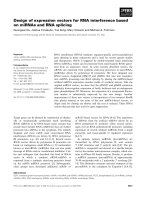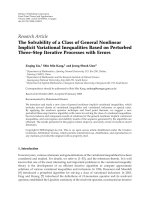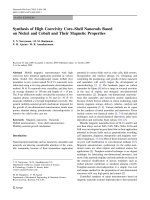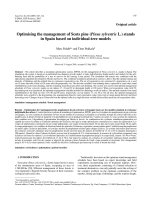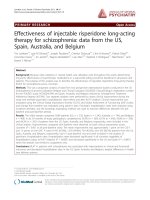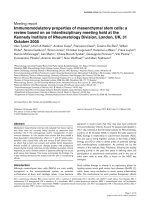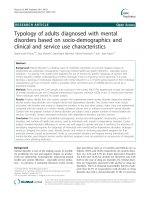This chapter studies the role of bank and nonbank fi nancial intermediaries in the provision of longterm fi nance. In particular, based on data from different fi nancial institutions, it reports on the extent to which fi nancial institutions hold longterm
Bạn đang xem bản rút gọn của tài liệu. Xem và tải ngay bản đầy đủ của tài liệu tại đây (990.78 KB, 14 trang )
1. Overview of the Asset Recovery
Process and Avenues for
Recovering Assets
One of the first considerations in an asset recovery case is the development of an effective strategy for both obtaining a criminal conviction (if possible) and recovering the
proceeds and instrumentalities of corruption. Practitioners must be aware of the various legal avenues available for recovering assets, as well as some of the factors or obstacles that may lead to the selection of one avenue over another. This chapter introduces
the general process for asset recovery and the various recovery avenues (most of which
are discussed in greater detail in subsequent chapters).
1.1 General Process for Asset Recovery
Whether pursuing assets through criminal or non-conviction based (NCB) confiscation or through proceedings in a foreign jurisdiction or through a private civil action,
the objectives and fundamental process for recovery of assets are generally the same.
Figure 1.1 illustrates this process.
1.1.1 Collection of Intelligence and Evidence and Tracing Assets
Evidence is gathered and assets are traced by law enforcement officers under the supervision of or in close cooperation with prosecutors or investigating magistrates, or by
private investigators or other interested parties in private civil actions. In addition to
gathering publicly available information and intelligence from law enforcement or
other government agency databases, law enforcement can employ special investigative
techniques. Some techniques may require authorization by a prosecutor or judge (for
example, electronic surveillance, search and seizure orders, production orders, or
account monitoring orders), but others may not (for example, physical surveillance,
information from public sources, and witness interviews). Private investigators do not
have the powers granted to law enforcement; however; they will be able to use publicly
available sources and apply to the court for some civil orders (such as production orders,
on-site review of records, prefiling testimony, or expert reports). Criminal investigative
techniques and tracing are discussed in detail in chapter 3, and investigative techniques
in civil actions are discussed in chapter 8.
FIGURE 1.1
Process for Recovery of Stolen Assets
Collecting Intelligence and Evidence and
Asset Tracing
(Domestically and in foreign jurisdictions using MLA)
Securing the Assets
(Domestically and in foreign jurisdictions using MLA)
Court Process
(To obtain conviction [if possible], confiscation, fines,
damages, and/or compensation)
Enforcing Orders
(Domestically and in foreign jurisdictions using MLA)
Return of Assets
Source: Authors’ illustration.
Note: MLA = mutual legal assistance.
1.1.2 Securing the Assets
During the investigation process, proceeds and instrumentalities subject to confiscation must be secured to avoid dissipation, movement, or destruction. In certain civil
law jurisdictions, the power to order the restraint or seizure of assets subject to confiscation may be granted to prosecutors, investigating magistrates, or law enforcement
agencies. In other civil law jurisdictions, judicial authorization is required. In common
law jurisdictions, an order to restrain or seize assets generally requires judicial authorization, with some exceptions in seizure cases. Asset restraint and seizure is discussed in
detail in chapter 4; restraint in private civil actions is discussed in chapter 8. Systems to
manage assets will also need to be in place (see chapter 5).
1.1.3 International Cooperation
International cooperation is essential for the successful recovery of assets that have been
transferred to or hidden in foreign jurisdictions. It will be required for the gathering of
evidence, the implementation of provisional measures, and the eventual confiscation of
the proceeds and instrumentalities of corruption. And when the assets are confiscated,
cooperation is critical for their return. International cooperation includes “informal
assistance,” mutual legal assistance (MLA) requests, and extradition.13 Informal assistance
13. For the purposes of this handbook, “informal assistance” is used to include any type of assistance that
does not require a formal MLA request. Legislation permitting this informal, practitioner-to-practitioner
6
I
Asset Recovery Handbook
is often used among counterpart agencies to gather information and intelligence to assist
in the investigation and to align strategies and forthcoming procedures for recovery of
assets. An MLA request is normally a written request used to gather evidence (involving
coercive measures that include investigative techniques), obtain provisional measures,
and seek enforcement of domestic orders in a foreign jurisdiction. International cooperation is addressed in chapter 7.
1.1.4 Court Proceedings
Court proceedings may involve criminal or NCB confiscation or private civil actions
(each described below and in subsequent chapters); and will achieve the recovery of
assets through orders of confiscation, compensation, damages, or fines. Confiscation
may be property based or value based. Property-based systems (also referred to as
“tainted property” systems) allow the confiscation of assets found to be the proceeds or
instrumentalities of crime—requiring a link between the asset and the offense (a requirement that is frequently difficult to prove when assets have been laundered, converted, or
transferred to conceal or disguise their illegal origin). Value-based systems (also referred
to as “benefit” systems) allow the determination of the value of the benefits derived from
crime and the confiscation of an equivalent value of assets that may be untainted. Some
jurisdictions use enhanced confiscation techniques, such as substitute asset provisions
or legislative presumptions to assist in meeting the standard of proof. Chapter 6 describes
these and other confiscation issues; chapter 8 describes private civil actions.
1.1.5 Enforcement of Orders
When a court has ordered the restraint, seizure, or confiscation of assets, steps must be
taken to enforce the order. If assets are located in a foreign jurisdiction, an MLA request
must be submitted. The order may then be enforced by authorities in the foreign jurisdiction through either (1) directly registering and enforcing the order of the requesting jurisdiction in a domestic court (direct enforcement) or (2) obtaining a domestic order based
on the facts (or order) provided by the requesting jurisdiction (indirect enforcement).14
This will be accomplished through the mutual legal assistance process (described above
and in chapter 7). Similarly, private civil judgments for damages or compensation will
need to be enforced using the same procedures as for other civil judgments.
1.1.6 Asset Return
The enforcement of the confiscation order in the requested jurisdiction often results in
the confiscated assets being transferred to the general treasury or confiscation fund of
assistance may be outlined in MLA legislation and may involve “formal” authorities, agencies, or administrations. For a description of this type of assistance and comparison with the MLA request process, see
section 7.2 of chapter 7.
14. See United Nations Convention against Corruption (UNCAC), art. 54 and 55; United Nations Convention against Transnational Organized Crime (UNTOC), art. 13; United Nations Convention against Narcotic Drugs and Psychotropic Substances, art. 5; and the Terrorist Financing Convention, art. 8. For
restraint or seizure, see UNCAC, art. 54(2).
Overview of the Asset Recovery Process and Avenues
I 7
the requested jurisdiction (not directly returned to the requesting jurisdiction).15 As a
result, another mechanism will be needed to arrange for the return of the assets. If
UNCAC is applicable, the requested party will be obliged under article 57 to return the
confiscated assets to the requesting party in cases of embezzlement of public funds or
laundering of such funds, or when the requesting party reasonably establishes prior
ownership. If UNCAC is not applicable, the return or sharing of confiscated assets will
depend on domestic legislation, other international conventions, MLA treaties, or special agreements (for example, asset sharing agreements). In all cases, total recovery may
be reduced to compensate the requested jurisdiction for its expenses in restraining,
maintaining, and disposing of the confiscated assets and the legal and living expenses
of the claimant.
Assets may also be returned directly to victims, including a foreign jurisdiction,
through the order of a court (referred to as “direct recovery”).16 A court may order
compensation or damages directly to a foreign jurisdiction in a private civil action.
A court may also order compensation or restitution directly to a foreign jurisdiction
in a criminal or NCB case. Finally, when deciding on confiscation, some courts have
the authority to recognize a foreign jurisdiction’s claim as the legitimate owner of
the assets.
If the perpetrator of the criminal action is bankrupt (or companies used by the perpetrator are insolvent), formal insolvency procedures may assist in the recovery process.
All of these mechanisms are explained further in chapters 7, 8, and 9.
A number of policy issues are likely to arise during any efforts to recover assets in
corruption cases. Requested jurisdictions may be concerned that the funds will be
siphoned off again through continued or renewed corruption in the requesting
jurisdictions, especially if the corrupt official is still in power or holds significant
influence. Moreover, requesting jurisdictions may object to a requested country’s
attempts to impose conditions and other views on how the confiscated assets should
be used. In some cases, international organizations such as the World Bank and civil
society organizations have been used to facilitate the return and monitoring of
recovered funds.17
15. Stolen Asset Recovery (StAR) Initiative Secretariat, “Management of Confiscated Assets” (Washington,
DC, 2009), />16. UNCAC, art. 53 requires that states parties take measures to permit direct recovery of property.
17. In 2007, the U.S. Department of Justice filed a civil confiscation action against a U.S. citizen indicted in
2003 for allegedly paying bribes to Kazakh officials for oil and gas deals. The action was for approximately
$84 million in proceeds. The American citizen agreed to transfer those proceeds to a World Bank trust fund
for use on projects in Kazakhstan. See “U.S. Attorney for S.D.N.Y, Government Files Civil Forfeiture Action
Against $84 Million Allegedly Traceable to Illegal Payments and Agrees to Conditional Release of Funds to
Foundation to Benefit Poor Children in Kazakhstan,” news release no. 07-108, May 30, 2007, http://www.
usdoj.gov/usao/nys/pressreleases/May07/pictetforfeiturecomplaintpr.pdf; World Bank, “Kazakhstan BOTA
Foundation Established,” news release no. 2008/07/KZ, June 4, 2008, />INTKAZAKHSTAN/News%20and%20Events/21790077/Bota_Establishment_June08_eng.pdf.
8
I
Asset Recovery Handbook
1.2 Legal Avenues for Achieving Asset Recovery
The legal actions for pursuing asset recovery are diverse. They include the following
mechanisms:
•
•
•
•
•
domestic criminal prosecution and confiscation, followed by an MLA request to
enforce orders in foreign jurisdictions;
NCB confiscation, followed by an MLA request or other forms of international
cooperation to enforce orders in foreign jurisdictions;
private civil actions, including formal insolvency process;
criminal prosecution and confiscation or NCB confiscation initiated by a foreign
jurisdiction (requires jurisdiction over an offense and cooperation from the jurisdiction harmed by the corruption offenses); and
administrative confiscation.
The availability of these avenues, either domestically or in a foreign jurisdiction, will
depend on the laws and regulations in the jurisdictions involved in the investigation,
as well as international or bilateral conventions and treaties. Box 1.1 outlines the various laws relevant to practitioners pursuing these avenues. In addition, there are other
legal, practical, or operational realities that will influence the avenue selected. Some of
these strategic considerations, obstacles, and case management issues are discussed in
chapter 2.
1.2.1 Criminal Prosecution and Confiscation
When authorities seeking to recover stolen assets decide to pursue a criminal case,
criminal confiscation is a possible means of redress. Practitioners must gather evidence,
trace and secure assets, conduct a prosecution against an individual or legal entity, and
obtain a conviction. After obtaining a conviction, confiscation can be ordered by the
court. In some jurisdictions, particularly common law jurisdictions, the standard of
proof for confiscation will be lower than the standard required for obtaining the conviction. For example, “balance of probabilities” will be needed for confiscation, whereas
“beyond a reasonable doubt” will be required for a conviction. Other jurisdictions apply
the same standard to both conviction and confiscation. See figure 2.1 in section 2.6.5
for an explanation of the standards of proof. Generally, unless enhanced confiscation
provisions apply, confiscation legislation will provide for confiscation of proceeds and
instrumentalities that are directly or indirectly traceable to the crime.18
18. The form and operation of “enhanced confiscation provisions” are discussed in more detail in chapter 6. Enhancements include substitute asset provisions that permit confiscation of assets not connected with a crime if the original proceeds have been lost or dissipated, presumptions about the
unlawful use or derivation of assets in certain circumstances, presumptions about the extent of unlawful benefits flowing from certain offenses, and the reversal of the onus and burden of proof in certain
circumstances.
Overview of the Asset Recovery Process and Avenues
I 9
BOX 1.1
Legal Framework for Asset Recovery
Legislation and procedures (domestic and foreign jurisdictions):
•
•
•
•
•
Confiscation provisions (criminal, NCB, administrative);
MLA;
Criminal law provisions and codes of procedures (corruption, money laundering);
Private (civil) law provisions and codes of procedure; and
Asset sharing laws.
International conventions and treatiesa
•
•
•
•
•
•
•
•
•
•
•
•
•
•
•
UNCAC;
United Nations Convention against the Illicit Traffic in Narcotic Drugs and
Psychotropic Substances;
UNTOC;
Organisation for Economic Co-operation and Development Convention on
Combating Bribery of Foreign Public Officials in International Business
Transactions;
Southeast Asian Mutual Legal Assistance in Criminal Matters Treaty;
Inter-American Convention against Corruption;
Council of Europe Convention on Laundering, Search, Seizure and Confiscation of the Proceeds of Crime (1990) and the revised Council of Europe
Convention on Laundering, Search, Seizure and Confiscation of the Proceeds of Crime and on the Financing of Terrorism (2005);
Council of the European Union Framework Decision 2003/577/JHA on the
Execution in the European Union of Orders Freezing Property or Evidence;
Council of the European Union Framework Decision 2006/783/JHA on the
Application of the Principle of Mutual Recognition to Confiscation Orders;
Southern African Development Community Protocol against Corruption
(2001);
African Union Convention on Preventing and Combating Corruption and
Related Offenses (2003);
Commonwealth of Independent States Conventions on Legal Assistance
and Legal Relationship in Civil, Family and Criminal Matters;
Scheme Relating to Mutual Assistance in Criminal Matters within the
Commonwealth (the Harare Scheme);
Mercosur Mutual Legal Assistance in Criminal Matters Treaty (Dec. No.
12/01); and
Bilateral MLA treaties.
a. See appendix J for available Web site resources.
10
I
Asset Recovery Handbook
International cooperation, including informal assistance and requests for MLA, will be
used throughout the process to trace and secure assets in foreign jurisdictions, as well
as to enforce the final order of confiscation.19
A benefit of criminal prosecution and confiscation is the societal recognition of the
criminal nature of corruption and the accountability of the perpetrator. Further,
penalties of imprisonment, fines, and confiscation serve to deter future offenders. In
addition, criminal investigators generally have the most aggressive means of gathering information and intelligence, including access to data from law enforcement
agencies and financial intelligence units (FIUs), use of provisional measures and
coercive investigative techniques (such as searches, electronic surveillance, examination of financial records or access to documents held by third parties), as well as
grand juries or other means of compelling testimony or evidence. And, in most
jurisdictions, MLA is provided only in the context of criminal investigations. However, significant barriers may exist to obtaining a criminal conviction and confiscation: insufficient evidence; lack of capacity or political will; or the death, flight, or
immunity of the perpetrator. Furthermore, the conduct giving rise to the request
may not be a crime in the jurisdiction where the relief is being sought. These and
other barriers are discussed in chapter 2.
1.2.2 Non-Conviction Based Confiscation
Another type of confiscation gaining traction throughout the world is confiscation without a conviction, referred to as “NCB confiscation.”20 NCB confiscation shares at least
one common objective with criminal confiscation—namely, the recovery and return of
the proceeds and instrumentalities of crime. Likewise, deterrence and depriving corrupt
officials of their ill-gotten gains are other societal equities realized by NCB confiscation.
NCB confiscation differs from criminal confiscation in the procedure used to confiscate
the assets. A criminal confiscation requires a criminal trial and conviction, followed by
the confiscation proceedings; NCB confiscation does not require a trial or conviction,
but only the confiscation proceedings. In many jurisdictions, NCB confiscation can be
established on a lower standard of proof (for example, the “balance of probabilities” or
“preponderance of the evidence” standard), and this helps ease the burden on the
authorities. Other (mainly civil law) jurisdictions require a higher standard of proof—
specifically, the same standard required to obtain a criminal conviction.
19. UNCAC, art. 54(1)(a); UNTOC, art. 13(1)(a); and United Nations Convention against Narcotic Drugs
and Psychotropic Substances, art. 5(4)(a) require states parties to take measures to give effect to foreign
orders.
20. Jurisdictions include Anguilla, Antigua and Barbuda, Australia, some of the provinces of Canada
(Alberta, British Columbia, Manitoba, Ontario, Quebec, Saskatchewan), Colombia, Costa Rica, Fiji, Guernsey,
Honduras, Ireland, Isle of Man, Israel, Jersey, Liechtenstein, New Zealand, the Philippines, Slovenia, South
Africa, Switzerland, Thailand, the United Kingdom, the United States, and Zambia. International conventions and multilateral agreements also have introduced NCB confiscation. See UNCAC, art. 53(1)(c) and
recommendation 3 of the Financial Action Task Force 40+9 Recommendations.
Overview of the Asset Recovery Process and Avenues
I 11
However, because NCB confiscation is not available in all jurisdictions, practitioners
may have difficulty obtaining MLA to assist with investigations and to enforce NCB
confiscation orders. NCB confiscation is discussed in greater detail in chapter 6.
1.2.3 Private Civil Action
Authorities seeking to recover stolen assets have the option of initiating proceedings in
domestic or foreign civil courts to secure and recover the assets and to seek damages
based on torts, breach of contract, or illicit enrichment.21 The courts of the foreign
jurisdiction may be competent if a defendant is a person (individual or business entity)
living or incorporated in the jurisdiction (personal jurisdiction), if the assets are within
or have transited the jurisdiction (subject matter jurisdiction), or if an act of corruption
or money laundering was committed within the jurisdiction. As a private litigant, the
authorities seeking redress can hire lawyers to explore the potential claims and remedies (ownership of misappropriated assets, tort, disgorgement of illicit profits, contractual breaches). The civil action will entail collecting evidence of misappropriation or of
liabilities based on contractual or tort damages. Frequently, it is possible to use evidence gathered in the course of a criminal proceeding in a civil litigation. It is also possible to seek evidence with the assistance of a court prior to filing an action.
The plaintiff usually has the option to petition the court for a variety of orders, including the following:
• Freezing, embargo, sequestration, or restraining orders (potentially with worldwide effect) secure assets suspected to be the proceeds of crime, pending the
resolution of a lawsuit laying claim to those assets. In some jurisdictions, interim
restraining orders may be issued pending the outcome of a lawsuit even before
the lawsuit has been filed, without notice and with extraterritorial effect. These
orders usually require the posting of a bond, guarantee, or other undertaking by
the petitioner.
• Orders against defendants oblige them to provide information about the source
of their assets and transactions involving them.
• Orders against third parties for disclosure of relevant documents are useful in
obtaining evidence from banks, financial advisers, or solicitors, among others.
• “No-say” (gag) orders prevent banks and other parties from informing the defendants of a restraint injunction or disclosure order.
• Generic protective or conservation orders preserve the status quo and prevent
the deterioration of the petitioner’s assets, legal interests, or both. Such orders
usually require showing the likelihood of success on the merits and an imminent
risk in delaying a decision.
The principal disadvantages of litigating in a foreign jurisdiction are the cost of tracing
assets and the legal fees entailed in obtaining relevant court orders. However, the litigant
21. UNCAC art. 53(a) calls on states parties to permit another state party to initiate a civil action in domestic courts.
12
I
Asset Recovery Handbook
has more control in pursuing civil proceedings and assets in the hands of third parties
and may have the advantage of a lower standard of proof. For example, civil cases in
common law jurisdictions usually are decided on a “balance of probabilities” or “preponderance of the evidence” standard.
Similarly, arbitration proceedings related to international contracts obtained through
bribes or illicit advantages awarded to corrupt officials may open promising avenues,
including the cancellation of contracts, and potential claims for torts or damages. These
avenues are discussed in greater detail in chapter 8.
1.2.4 Actions Initiated by Foreign Jurisdictions
Authorities seeking to recover stolen assets may choose to support a criminal or NCB
confiscation proceeding that has been initiated in another jurisdiction against the corrupt official, associates, or identified assets. At the conclusion of the proceedings, the
state or government may be able to obtain a portion of the recovered assets through
orders of the foreign courts or pursuant to legislation or agreements.22 This will require
that the foreign authority has jurisdiction; the capacity to prosecute and confiscate;
and, most important, the willingness to share the proceeds. The initiation of an action
by a foreign authority may take place in one of two ways:
1. Authorities in the jurisdiction harmed by corruption may ask the foreign authorities to open their own case. This may be accomplished by filing a complaint or,
even more simply, by sharing incriminating evidence and a case file with authorities of the foreign jurisdiction. In all cases, the foreign authorities ultimately have
the discretion to pursue or ignore the case. If authorities pursue it, the jurisdiction harmed by the offenses will need to cooperate with the foreign authorities to
ensure they have the necessary evidence.
2. Foreign authorities may open a case independent of request from the jurisdiction
harmed by corruption. Foreign authorities may receive information linking a
corrupt official to their jurisdiction—whether through a newspaper article, a suspicious transaction report (STR), or a request for informal assistance or MLA—
and decide to investigate money laundering or foreign bribery activities undertaken within their national territory.
The involvement of the victim—including a state or government that has been harmed
by corruption offenses—in the proceedings is generally encouraged in most jurisdictions; however, it generally is limited to discussions with practitioners and does not
extend to actual standing in the proceedings. In some civil law jurisdictions, however, it
may also be possible for the victim to participate in foreign proceedings as a private
prosecutor or as a civil party to the proceedings. In both civil and common law jurisdictions, it may be possible to recover assets from these proceedings through court-ordered
compensation, restitution, or damages as a party harmed by corruption offenses or as a
legitimate owner in confiscation proceedings.
22. UNCAC art. 53(b) and 53(c) require states parties to take measures to permit direct recovery.
Overview of the Asset Recovery Process and Avenues
I 13
This avenue is an interesting option if the jurisdiction seeking redress does not have
the legal basis, capacity, or evidence to pursue an international investigation on its
own. Moreover, if the limitation period rules out the prosecution of the initial corruption charges, it may be possible to investigate offenses of money laundering or possession of stolen assets in other jurisdictions. On the other hand, the jurisdiction that has
been harmed by corruption offenses has no control over the proceedings, and success
largely depends on the foreign authorities’ priorities. In addition, unless the return of
the assets is ordered by the court, it will be dependent on asset sharing agreements or
the authorities’ ability to return the assets on a discretionary basis (see section 9.4 in
chapter 9).
1.2.5 Administrative Confiscation
Unlike criminal or NCB confiscation, which requires court action, administrative confiscation generally involves a non-judicial mechanism for confiscating assets used or
involved in the commission of the offense. It may occur by operation of statute, pursuant to procedures set out in regulations, and is typically used to address uncontested
confiscation cases. The confiscation is carried out by an authorized agency (such as a
police unit or a designated law enforcement agency), and often follows a process similar
to that traditionally used in customs smuggling cases. The procedures usually require
notice to persons with a legal interest in the asset and publication to the public at large.
Generally, administrative confiscation is restricted to low-value assets or certain classes
of assets. For example, legislation may permit the confiscation of any amount of
cash, but prohibit the confiscation of real property. Another variation on this type of
confiscation, called “abandonment” by some jurisdictions, employs a similar procedure. Another non-judicial means to recover assets is through taxation of the illicit
profits (see box 1.2).
1.3 Use of Asset Recovery Avenues in Practice: Three Case Examples
Outlined below are three short case examples that demonstrate how the various avenues
discussed throughout this chapter have been used to recover assets in practice. Each
case involved several jurisdictions and incorporated a number of different strategic
approaches, depending on the circumstances of the case, the avenues available in the
domestic and foreign jurisdictions, or repatriation arrangements.
1.3.1 Case of Vladimiro Montesinos and His Associates
Following televised videos that showed Vladimiro Montesinos (personal adviser to
Peru’s president Alberto Fujimori and de facto chief of Peru’s intelligence service) bribing an elected opposition congressman in September 2000, funds were traced to several
jurisdictions, including the Cayman Islands, Luxembourg, Switzerland, and the United
States. Ultimately, more than $250 million was recovered from Switzerland and the
United States and from local banks in Peru.
14
I
Asset Recovery Handbook
BOX 1.2
Alternative Means of Recovering Assets
Taxation of Illicit Profits
A public official or an executive from a state-owned company who receives
bribes, misappropriated funds, or stolen assets may be liable for income taxes on
this illicit income. In such a case, authorities do not have to prove the illicit origin
of assets. It is sufficient to prove that they represent undisclosed revenue. The
authorities simply prove that the taxpayer has made a taxable gain or received
taxable income and that he or she is liable for the appropriate amount of taxes,
including interest and penalties if the tax was not paid on time. Therefore, the
evidentiary burden is less than in a civil recovery case. Given the fact that this
approach generally does not involve court proceedings, this mechanism is potentially cheaper and faster than civil recovery or criminal proceedings.
Fines and Compensation Orders in Criminal Trials
In criminal cases, the court may order the defendant to pay fines, compensation
to the victim, or both. Such orders may accompany confiscation orders, or may
be ordered in lieu of confiscation orders. Although fines or compensation orders
may be easier to achieve than a separate proceeding for confiscation, the enforcement of such orders is likely to be more difficult. Enforcement of fines and compensation orders may proceed through civil courts, whereas confiscation orders
will be enforced against assets that have been previously restrained. In addition,
the amount of the fine may be limited by statute and therefore insufficient on its
own to meet the recovery being sought.
For the $48 million of assets in Switzerland, two options were discussed with the Swiss
investigating magistrate: The Peruvian authorities could prosecute the offenders domestically for corruption and then seek recovery of the assets through MLA requests and
signed waivers. Or Switzerland could pursue drug trafficking and related money laundering offenses that were involved in the case. With the second option, recovery would
be reduced because Peru would have to share a percentage of the assets with Switzerland.
Peru decided to pursue the first option. To lay the groundwork, Peruvian authorities
introduced legislation permitting guilty pleas (plea agreements) and other forms of
cooperation.23 In return for a reduced criminal sentence or dismissal of proceedings,
defendants provided useful information regarding known or unidentified crimes and
unknown evidence, access to the proceeds of crime, or testimony against key figures. In
addition, defendants signed waivers authorizing the foreign banks that held their money
to transfer it to the Peruvian government accounts. Several million dollars were recovered through the use of these waivers.
23. Referred to as the “Efficient Collaboration Act” (Law 27.378).
Overview of the Asset Recovery Process and Avenues
I 15
For the assets allegedly in the Cayman Islands, Peru hired local lawyers to assist with
pursuit of $33 million transferred through a Peruvian bank. Peruvian authorities also
met with the FIU to seek its assistance. After several months of financial analysis, Peru
discovered that the money had never been sent to the Cayman Islands, but had remained
in the Peruvian bank. A back-to-back loan scheme had been used to simulate the
“transfer” to the Cayman bank and the “return” to the Peruvian bank. When this was
discovered, the funds in the Peruvian bank were seized.
In the United States, Victor Venero Garrido, an associate of Montesinos, was arrested in
coordination with the Peruvian authorities; his apartment was seized; and $20 million
was frozen. Another $30 million of Montesinos’ funds held in the name of a front man
were also frozen. NCB confiscation proceedings in California and Florida were used to
recover the funds, and the entire amount was repatriated to Peru. The repatriation agreement with the United States was conditioned on the investment of the money in human
rights and anticorruption efforts.
In Peru, more than $60 million was recovered by Peruvian authorities seizing and confiscating properties, vehicles, boats, and other assets through approximately 180 criminal proceedings involving more than 1,200 defendants.
1.3.2 Case of Frederick Chiluba and His Associates
In 2002, a task force was established in Zambia to investigate corruption allegations
against the former president Frederick Chiluba and his associates during the period
1991–2001, to assess whether criminal proceedings could be brought, and to determine
the best options for recovering assets. In 2004, the attorney general of Zambia initiated
a civil suit in the United Kingdom to recover funds transferred to London and across
Europe between 1995 and 2001 to fund the former president’s expensive lifestyle—
including a residence valued at more than 40 times his annual salary.24 These proceedings were launched in addition to ongoing criminal proceedings in Zambia.
Three factors informed the decision to launch the civil action in addition to the criminal
proceedings: First, most of the defendants were located in Europe, making domestic
criminal prosecution and confiscation impossible in a number of cases.25 Second, most
of the evidence and assets were located in Europe, which made a European venue a more
favorable option. And, third, specifically with respect to the cases whereas domestic
criminal prosecution and confiscation was possible, successful international cooperation through an MLA request was unlikely. Zambia lacked the bilateral or multilateral
agreements, procedural safeguards, capacity, and experience necessary to collect evidence and enforce confiscation orders across Europe. Instead, court orders obtained in
a European jurisdiction would be easier to enforce in jurisdictions that were parties to
the Brussels Convention on recognition of foreign court decisions in Europe.
24. Attorney General of Zambia v. Meer Care & Desai & Others, [2007] EWHC 952 (Ch.) (U.K.).
25. Zambia did not have NCB confiscation legislation at that time; however, it was adopted subsequently.
16
I
Asset Recovery Handbook
London was chosen as the European venue because most of the funds diverted from
Zambia had passed through two law firms and bank accounts in the United Kingdom,
and the attorney general of Zambia was able to establish jurisdiction over defendants in
jurisdictions that were parties to the Brussels Convention. Finally, it was anticipated
that decisions obtained from courts in the United Kingdom would also be enforceable
in Zambia when they were registered before the courts.
The High Court of London found sufficient evidence of a conspiracy to transfer approximately $52 million from Zambia to a bank account operated outside ordinary government business—the “Zamtrop account”—and held at the Zambia National Commercial
Bank in London. Forensic experts traced the monies received in the Zamtrop account
back to the ministry of finance. They also substantially traced the funds leaving the
Zamtrop account, and they revealed that $25 million was misappropriated or misused.
In addition, the High Court found no legitimate basis for payments of about $21 million
made by Zambia pursuant to an alleged arms deal with Bulgaria and paid into accounts
in Belgium and Switzerland.
The Court held that the defendants conspired to misappropriate $25 million from the
Zamtrop account and $21 million from the arms deal payments. The Court also held
that the defendants had broken the fiduciary duties they owed to the Zambian Republic
or dishonestly assisted in such breaches. As a result, the defendants were held liable for
the amounts and assets corresponding to misappropriated funds.
1.3.3 Case of Diepreye Alamieyeseigha
In the case involving Diepreye Peter Solomon Alamieyeseigha, former governor of
Bayelsa State, Nigeria, this jurisdiction was able to recover $17.7 million through domestic proceedings and through cooperation with authorities in South Africa and the
United Kingdom.
In September 2005, Alamieyeseigha was first arrested at Heathrow Airport by the
London Metropolitan Police on suspicion of money laundering. An investigation
revealed that Alamieyeseigha had $2.7 million stashed in bank accounts and in his
home in London, as well as London real estate worth an estimated $15 million.
Alamieyeseigha was released on bail and subsequently left the jurisdiction in November
2005, returning to Nigeria.
In Nigeria, he claimed immunity from prosecution. He was subsequently removed
from office by Bayelsa State’s lawmakers, and thereby lost his immunity. Later in
November 2005, Nigeria’s Economic and Financial Crimes Commission charged him
with 40 counts of money laundering and corruption, and it secured a court order
restraining assets held in Nigeria.
For assets in the United Kingdom, close cooperation between the Commission and the
London Metropolitan Police’s Proceeds of Corruption Unit was crucial. The $1.5 million
in cash seized from Alamieyeseigha’s London home was confiscated under the Proceeds
Overview of the Asset Recovery Process and Avenues
I 17
of Crime Act on the basis of a court order that the assets represented proceeds of crime.
In May 2006, the court ordered the funds repaid to Nigeria, and the transfer was made a
few weeks later. For the bank accounts, the process was more challenging because assets
and evidence were located in the Bahamas, the British Virgin Islands, the Seychelles,
South Africa, and the United Kingdom. Nigerian authorities recognized that requesting
assistance from these jurisdictions could take considerable time and that orders from
Nigerian courts would not necessarily be executed. In addition, the pursuit of legal proceedings in each of these jurisdictions was a daunting prospect because the Nigerian
authorities had little evidence linking Alamieyeseigha to these assets and linking the
assets to acts of corruption.
As a result, Nigerian authorities decided to bring civil proceedings in the United Kingdom
and simultaneously pursue criminal proceedings in Nigeria. To secure evidence, the Nigerian authorities obtained a disclosure order for the evidence compiled by the Metropolitan Police in the course of its investigation.26 Nigeria was able to use this evidence together
with Alamieyeseigha’s income and asset declaration27 to obtain a worldwide restraint
order covering all assets owned directly or indirectly by Alamieyeseigha and a disclosure
order for documents held at banks and by Alamieyeseigha’s associates.
In parallel with those proceedings, the South African Asset Forfeiture Unit initiated
NCB confiscation proceedings against Alamieyeseigha’s luxury penthouse. Funds were
returned to Nigeria following the sale of the property in January 2007.
Before a Nigerian high court in July 2007, Alamieyeseigha pleaded guilty to six charges
of making false declaration of assets and caused his companies to plead guilty to 23
charges of money laundering. He was sentenced to two years in prison, and the court
ordered the confiscation of assets in Nigeria. Alamieyeseigha’s guilty pleas effectively
voided his defense in the civil proceedings in the London High Court; and, in December
2007, the Court issued a summary judgment confiscating property and a bank account
in the United Kingdom. A judgment in July 2008 led to the confiscation of the remaining assets in Cyprus, Denmark, and the United Kingdom.
26. The Nigerian application for disclosure was not contested by the Metropolitan Police. This departed
from the usual practice: the police usually do not concede to providing evidence gathered through criminal
investigations to assist private parties pursuing civil claims.
27. The declaration was filed in 1999 when Alamieyeseigha was first elected state governor. It indicated that
he had assets amounting to just over half a million dollars and an annual income of $12,000.
18
I
Asset Recovery Handbook
